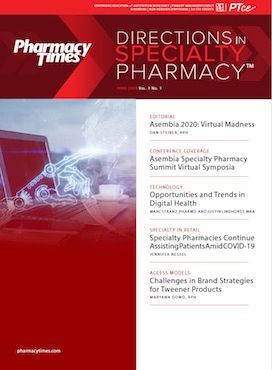Publication
Article
Specialty Pharmacy Times
Psoriatic Arthritis: Experts Discuss Treatment Responsiveness and Cost
A virtual symposium held in conjunction with the Asembia Specialty Pharmacy Summit focused on psoriatic arthritis.
PSORIATIC ARTHRITIS (PsA), an inflammatory arthritis, affects about 30% of patients with psoriasis. Approximately 60% of patients who have this arthritis will experience progressive, erosive, and deforming joint damage. A virtual symposium held in conjunction with the Asembia Specialty Pharmacy Summit focused on this disease.
The first session, presented by Geoffrey Wall, PharmD, BCPS, FCCP, covered the background of PsA, which is becoming increasingly more familiar to pharmacists—and more treatable. The economic burden of PsA is significant, at approximately $135 billion per year, based on 2013 data and probably more now.
Wall next narrowed the discussion to the clinical presentation of PsA, which typically develops between 7 and 10 years after a psoriasis diagnosis (and translates to a treatment onset at age 30 to 50 years), although it can develop at any time. He augmented his presentation with photographs of dactylitis, enthesitis, skin and joint inflammation, and arthritis mutans.
Wall explained that unfortunately, patients who develop PsA often have comorbidities, including cancer, cardiovascular disease, depression, and metabolic syndrome. He emphasized the importance of addressing underlying conditions concurrently with the psoriatic condition.
Jamie McConaha, PharmD, NCTTP, BCACP, CDCES, picked up where Wall left off to discuss clinical updates. She covered PsA guidelines: the American College of Rheumatology and National Psoriasis Foundation (ACR/NPF) Clinical Practice Guidelines and the European League Against Rheumatism recommendations for management of PsA with pharmacologic therapies.
After reviewing treatment goals, McConaha discussed nonpharmacological therapies and symptomatic treatment, then launched into a discussion of targeted therapies. Addressing each of the various approved therapies based on its mechanism of action, McConaha presented concise summaries of general principles. Many of these are familiar to pharmacists, but some were new and represented clinical pearls for practice. She also discussed an emerging treatment that is currently in clinical trials.
McConaha transitioned back to Wall to discuss specialty pharmacy considerations. Treatment and its associated costs are an important consideration. Early referral is crucial, and screening for PsA in all patients who have psoriasis is critical. He reviewed a number of cost-effectiveness studies that indicate screening is indeed cost-saving in the long run.
Wall also discussed the cost of immunomodulators. Currently, the FDA has approved 9 medications: adalimumab, apremilast, certolizumab, etanercept, golimumab, infliximab, secukinumab, tofacitinib, and ustekinumab. After his review and analysis of studies, he indicated that most costs of biologics fall within willingness-to-pay thresholds based on quality-of-life years gained. Wall emphasized that the pharmacist’s role is to monitor PsA progression, educate patients thoroughly and constantly, keep an eye on treatment outcomes, and promote monitoring.
The faculty closed the session by discussing critical counseling points when talking to patients with PsA. In this disease, tailoring counseling to individual patients is critical as they will have different presentations and concerns.







